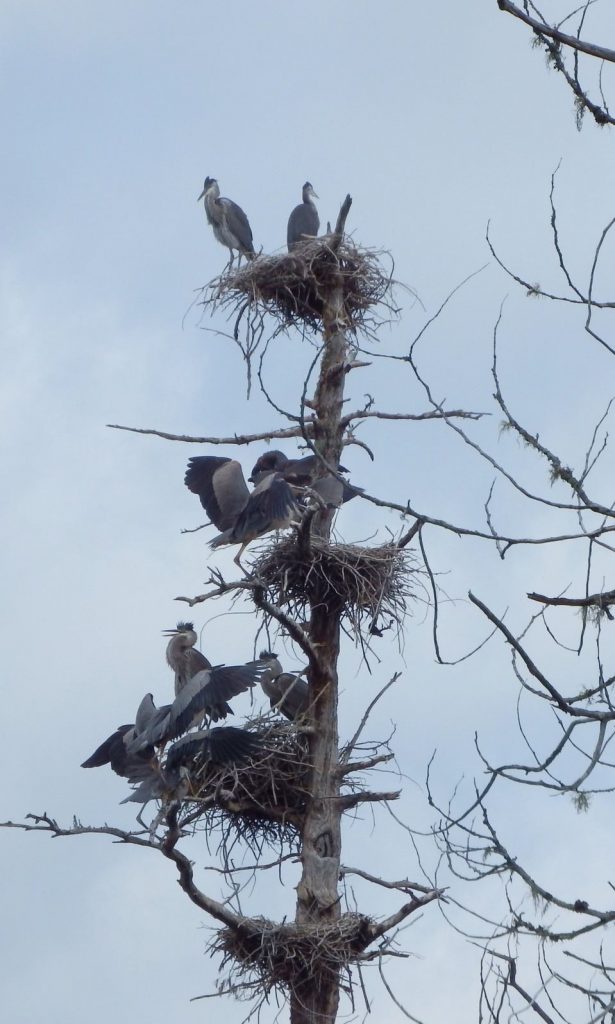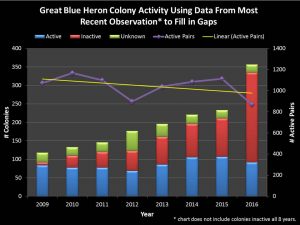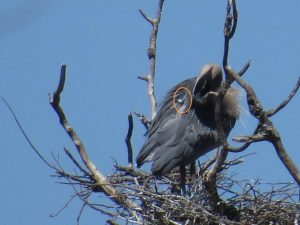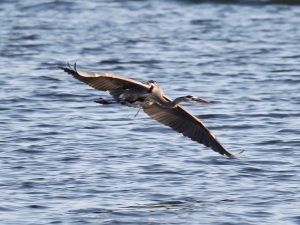February 15, 2017 at 10:24 pm

Young herons close to fledging at a colony in Milbridge. Photo by HERON Volunteer, Dick Brubaker.
Now that winter has finally decided to show up in Maine, I figured I should report on our 2016 field season before the 2017 season is knocking at our door. I guess it takes a blizzard to get me to stay put long enough to enter and analyze the past year’s volunteer monitoring data! The Heron Observation Network’s volunteers have been monitoring great blue heron colonies across Maine for eight years now, and this past year’s effort was just as important as the first year of monitoring. We had 71 volunteers monitor 109 colonies this year, with well over 224 ground visits. Thirty-two of our volunteers documented their time and mileage, and reported a total of 542 hours and 5,517 miles. Those hours and miles are equivalent to over $14,000 in match that will be used to leverage federal funds for more survey, monitoring, and research efforts. A big thank you to all those who participated! While our volunteer numbers were similar to past years, the number of active colonies and nesting pairs observed was a bit lower: 63 colonies with 537 pairs. Since not all colonies get monitored every year, we use the most recent data available for each colony to fill in the gaps and better represent the nesting activity at known colonies. When we fill in the gaps for this year’s monitoring effort, we end up with a total of 92 active colonies with 870 nesting pairs. This is less than what was observed the previous seven years, which averaged 1068 nesting pairs (see graph). Maine’s largest great blue heron colony that typically hosts 100-120 pairs was not active this year, and thus is a big part of this drop in total nesting pairs. We do not know if the drop in nesting pairs at this colony (or statewide) is primarily due to a shift in nesting activity to sites yet undiscovered, or due to a real drop in nesting pairs. We hope to eventually answer this question of population trend by repeating our dual-frame aerial survey effort that was conducted in 2015.
(click graph to enlarge in browser)
The 2015 dual-frame aerial survey was designed to take advantage of the previous six years of monitoring data produced by volunteers. We searched for new colonies in randomly selected plots and checked most of our known sites for activity to produce our first statistically valid breeding population estimate for Maine’s great blue herons: 1,524 nesting pairs (credible interval = 1,363-1,732). The data collected this past year and the next three years will directly feed into the survey design for 2020. The more current and thorough our coverage is, the better our estimate will be in 2020. By comparing the 2015 and 2020 estimates, we will determine how our herons are faring statewide as well as in various regions of the state. Therefore, the colony data provided by Heron Observation Network volunteers are key to determining the population trend of great blue herons in Maine. Every year there are colonies that need a monitor, so don’t hesitate to contact me to get involved!
GPS-tagged great blue heron, Snark, preening at his nest this past summer. Photo by HERON Volunteers, Jane Rosinski and Gordon Russell.
Great blue herons are currently listed as a Species of Special Concern in Maine primarily due to the decline of nesting pairs along the coast and the question of whether this decline could be occurring statewide. Monitoring their numbers statewide over the past eight years has brought up more questions than answers. We realize there is a lot of basic natural history information that we do not know about this species. We hope to discover some answers, or at least clues, by tracking individual birds over multiple years. If you have followed along with HERON, you already know about our five great blue herons tagged with GPS transmitters this past June. We have already learned about their home ranges during nesting, post-breeding, and wintering; the timing and paths of their southward migration; and their wintering locations (Florida, Cuba, and Haiti!). We are looking forward to following them on their spring migration back to Maine and to see how their habits compare to last year’s. Won’t you follow along, too?
GPS-tagged great blue heron, Snark, photographed in Vero Beach, Florida by HERON Volunteers, Doug and Paula Albert.
You can follow them via the movebank.org website, the smartphone Animal Tracker app, or the HERON Facebook Page. For more information about the tracking project, including detailed instructions for tracking the herons online, click here.


